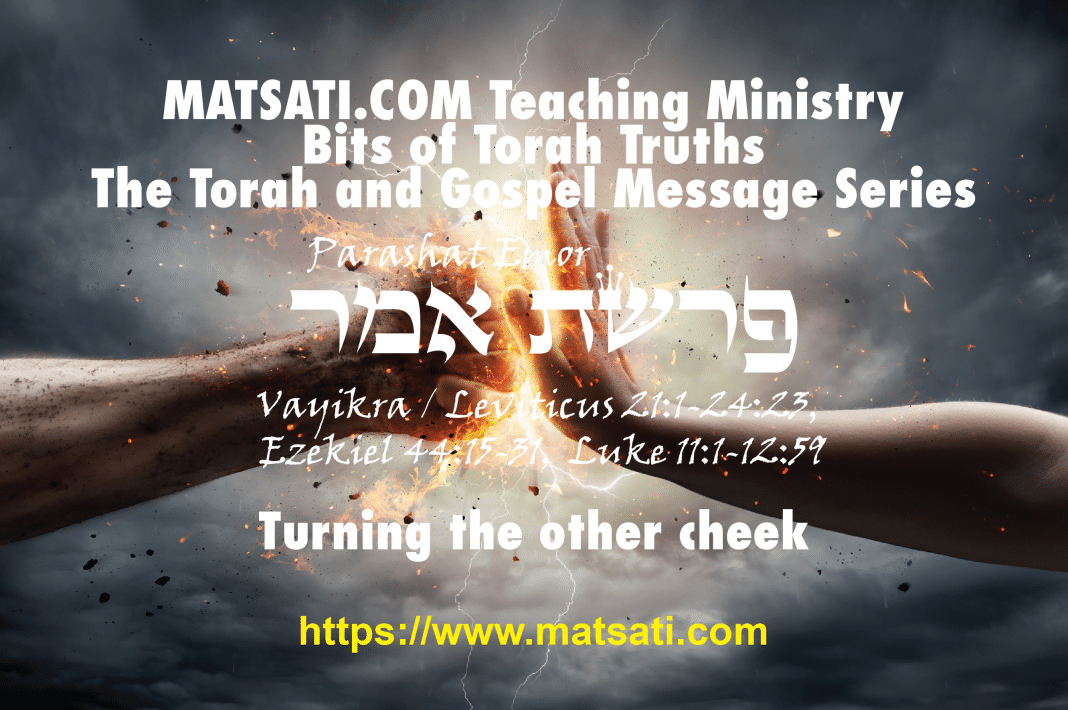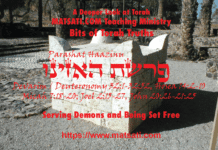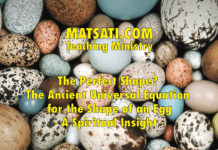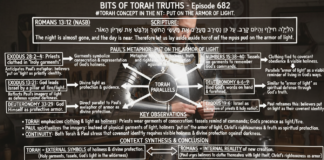This week’s Torah portion contains the verse that states “an eye for an eye and a tooth for a tooth.” Bible scholars generally interpret “eye for eye,” as being derived from the ancient Babylonian Code of Hammurabi, as a restriction on retaliation for personal injuries meaning that one was only to take an eye for an eye. Most people understand this as a means for retaliation, God giving us permission to punch someone who has punched us, etc. When we begin to study the Torah commands, especially this one in light of what Scripture says elsewhere, this command is about having just scales in judgment, but there is also something more to this verse. The interpretation of Vayikra / Leviticus 24:20, כ שֶׁבֶר תַּחַת שֶׁבֶר עַיִן תַּחַת עַיִן שֵׁן תַּחַת שֵׁן כַּאֲשֶׁר יִתֵּן מוּם בָּאָדָם כֵּן יִנָּתֶן בּוֹ: 24:20 fracture for fracture, eye for eye, tooth for tooth; just as he has injured a man, so it shall be inflicted on him. (NASB) is this does not necessarily suggest one is to inflict injury on a man as he did to the other. Mamionides states that a ransom may be paid instead of taking a literal interpretation of this verse (except in the case of a capital crime). Now the interesting thing about the Talmud is the Talmud contains varying opinions with the rabbis arguing over their differing opinions. (see Talmud Bavli Bava Kamma 83b and Mishnah Bava Kamma 8:1) Here, the rabbis say the “eye for an eye” command is to be understood as paying compensation rather than literally cutting off an hand or putting out an eye. The reason for this interpretation is that it is traditionally only financial compensation was made as opposed to the literal cutting off from the human body. (see Sforno on Shemot / Exodus 21:24) Sforno comments how it is difficult to measure accurately how to apply the principle of an eye for an eye. The reason being, there is always more to the story than what we know, or the situation is more complicated than simply to cut off one’s hand or pluck out one’s eye, etc.
In Matthew 5:38-42 we read how Jesus repudiates the notion of eye and tooth saying, “Ye have heard that it hath been said, An eye for an eye, and a tooth for a tooth: But I say unto you, That ye resist not evil: but whosoever shall smite thee on thy right cheek, turn to him the other also. And if any man will sue thee at the law, and take away thy coat, let him have thy cloak also. And whosoever shall compel thee to go a mile, go with him twain. Give to him that asketh thee, and from him that would borrow of thee turn not thou away.” The reason for this interpretation is according to the Apostolic Writings, this particular commandment was taken by some to be applied to every day personal relationships. This allowed one to be able to seek revenge on a personal level. (i.e. If someone punched you, you could punch him back; if someone insulted you, he was fair game for your insults, etc.) Note how this is consistent with the interpretation by most people today on the meaning of an “eye for an eye, and a tooth for a tooth.” The religious leaders of Yeshua’s day played games with the judicial basis of the giving of the command “an eye for an eye.” In the Sermon on the Mount, Yeshua counters the common teaching of personal retaliation saying: “… resist not evil: but whosoever shall smite you on your right cheek, turn to him the other also.” (Matthew 5:38–39) Here Yeshua raises the bar interpreting the command on and “eye for an eye” as to be merciful towards those who wrongfully treat us. This is referring to the one who has intentions of doing evil towards another as opposed to accidental harm being done. Nevertheless, even in the context of willful sin that is committed against us, we are to offer mercy and turn the other cheek.
In addition to these things, the Scriptures from both the Torah Portion and the Haftarah Portion state the following, Ezekiel 44:19, יט וּבְצֵאתָם אֶל-הֶחָצֵר הַחִיצוֹנָה אֶל-הֶחָצֵר הַחִיצוֹנָה אֶל-הָעָם יִפְשְׁטוּ אֶת-בִּגְדֵיהֶם אֲשֶׁר-הֵמָּה מְשָׁרְתִם בָּם וְהִנִּיחוּ אוֹתָם בְּלִשְׁכֹת הַקֹּדֶשׁ וְלָבְשׁוּ בְּגָדִים אֲחֵרִים וְלֹא-יְקַדְּשׁוּ אֶת-הָעָם בְּבִגְדֵיהֶם: 44:19 ‘When they go out into the outer court, into the outer court to the people, they shall put off their garments in which they have been ministering and lay them in the holy chambers; then they shall put on other garments so that they will not transmit holiness to the people with their garments. (NASB) What we find here in the book of Ezekiel is a command taken from Vayikra / Leviticus 16:23 Then Aaron shall come into the tent of meeting and take off the linen garments which he put on when he went into the holy place, and shall leave them there. (NASB) Moshe commands Aaron what to do concerning making atonement on Yom Kippur, and he tells Aaron to leave the holy garments in the Tabernacle, those garments that he wore while going before God to make atonement. This is an interesting point since Ezekiel 44:19 speaks of leaving the garment in the Temple by reason of holiness not being transmitted to the people via the garments. This is an interesting comment when paralleled with what we read in Vayikra / Leviticus 15 on the transmittance of uncleanness. Based upon the Torah, we generally do not think in terms of the transmittance of holiness as opposed to the transmittance of uncleanness. The Hebrew Text on Vayikra / Leviticus 15 describes what occurs following one having the uncleanness of a discharge from the body. Based upon the Torah study from Parashat Metzora, we learned about uncleanness and its connected to sin, and how the rabbis interpret Metzora as “hamotzi ra” (the wellspring of evil) those things which come from the heart is the source / origin of leprosy. Detailed in Vayikra / Leviticus 15, the man who has a discharge, whatever he touches becomes unclean (15:7, 15:9-11), everything on which he sits becomes unclean (15:4), anyone who touches his bed becomes unclean (15:5), whoever sits on the thing that he sat upon becomes unclean (15:6), if the unclean person spits upon someone else, he becomes unclean (15:8). The text goes on to say clay vessels that were touched are to be broken because they are unclean (15:12), and when a person is cleansed from the discharge, he is to wait seven days for his cleansing to be complete, and he is to wash his cloths and body in running water (יִשָּׁטֵף בַּמָּיִם). The Torah describes the transmittance of uncleanness to objects and to others. In the Talmud Bavli Niddah 54 the rabbis describe the menstruating woman as a more stringent case than what is referred to here in Vayikra / Leviticus 15 on the one with a discharge. In the case of a woman, menstrual blood confers uncleanness when either wet or dry, whereas the one with a discharge confers uncleanness only when wet. Also, a menstruating woman causes impurity as soon as she has spotted blood the first time, whereas the blood of a person afflicted with זִיבָה transmits impurity only after several sightings or sightings on consecutive days respectively. What these things describe for us are how every aspect of our lives is spiritual influencing even what we touch. We have a spiritual influence upon everything in our lives, persons, places, and things. This is definitely food for thought in regard to how we are to live our lives! This also adds additional insights into the meaning of the command “an eye for an eye and a tooth for a tooth.”
The, idea of the cloths consecrating Aaron and his Sons, the Temple garments were meant to set apart the duties of the priesthood from the normal duties that are common to the people of Israel. This is command was given for the purpose of preventing confusion of the religious duties of the Levi (the priest) with the normal duties of the common man (i.e. this helped to eliminiate confusion between the religious and non-religious lives of the people). Note also however, we find in the Torah the words “and unto Me you shall be a kingdom of priests, a holy nation” (Shemot / Exodus 19:6). What we are being taught is how the children of God are to live their lives and respecting the position of the anointed one of God in the Temple service. The Apostolic Writings have similar verbiage regarding those who believe in Yeshua the Messiah and become a part of the family of God. This provides some tension in the sense of every person sanctifying (setting apart) his or her life before God. What this command does is to help recognize the specific context of the consecration or sanctification process as the priests are the one’s who were authorized by God to carry out these duties. This also reminds us as non-Levites how we should be living and sanctifying our lives before God! (i.e. separating outselves from the world) Taking these things together, the transmission of uncleanness and holiness, of the priestly duties of every person to be holy, and the command an “eye for an eye,” there is a very important point that appears to be drawn out per what we are reading in these biblical texts. Yeshua points out something that seems to be related to what we are reading in both the Torah and the Haftarah portion on the command “an eye for an eye” and to transmitting holiness to the people. In the command of “an eye for an eye” we are given the opportunity to be merciful regardless how we are being treated. Yeshua says do not resist evil but turn the other cheek. The idea here Yeshua is teaching us is related to both mercy and righteousness having the opportunity to touch the unrighteous person who is sinning. Under the idea of “transmitting holiness,” by turning the other cheek, the unrighteous may see the mercy and love of God demonstrated in the life of the child of God. This action then may have a property of drawing the unrighteous person to faith in the God of Israel and His Messiah Yeshua.
The concept here is the sinner is being confounded by “love your enemy.” (i.e. experiencing something against their expectations.) Through the love and mercy of God’s people, the unrighteous person “may” come to his senses and repent and seek the God of Israel, and turn from his wicked ways, and then the Lord God Almighty will cause his heart to change and seek the righteousness and holiness of both our Father in heaven and of His Son Yeshua! This may be analogous to transmitting holiness in the sense of one’s life may be changed and transformed, by the sinner seeking to receive the Spirit of God through faith in Yeshua the Messiah. The Holy Spirit of God then begins to transform one into the likeness of God’s Son Yeshua the Messiah. A proper understanding of the Commandments, such as the “eye for an eye and tooth for a tooth,” helps us to more accurately understand the meaning of Yeshua’s Words and teachings! The concept King Solomon gave us according to the text in Mishley / Proverbs 25:21-22 (feeding your enemy), through the eyes of the rabbinic commentary, it is God Himself who will work to establish peace between our enemies. (See 2 Kings 6 for further study) The point is the would be victim shows kindness in obedience to the Scriptures, the Lord God will cause one’s enemies to be at peace, thus turning one’s would be murderer (i.e. hate = murder) into a friend. Winning over an enemy is a sign of great moral strength and the Talmud praises the attitude of humility and long suffering when an individual must endure personal insult. The rabbis say those who are reviled and do not respond likewise rejoice in the teaching, “but they who love him are as the sun when it goes forth in its might” (Judges 5:31). Turning the other cheek is not a sign of weakness, it demonstrates an inner strength that transforms the disciple in the midst of suffering and possesses the power to transform the aggressor who may decide to change and seek God. (Talmud Bavli Shabbat 88b) By being touched with righteousness and mercy, one’s life may be drawn to seeking the Lord God of Israel, His Messiah Yeshua, and bringing glory to the Name of God by living for Him, showing mercy and love towards one another just as the Scriptures say! This has parallels to the teaching on transmitting holiness to others. For the person who does this, salvation has come. When we study God’s Word from the beginning of the Bible (the Torah) to the end (Revelation) we can see how there is much practical application for us today in the Tanach (Torah, Prophets, Writings) and the NT. In many churches the OT is placed in opposition to the NT under the idea the “eye for an eye” command is a different, antithetical command from the “love your enemy” and “grace” of God. In truth, the Torah contains both many examples of the grace of God, and the command to “love your neighbor as yourself.” (Vayikra / Leviticus 19:17-18) To place the Torah in antithesis to the NT is evidence of not understanding the Torah, and of having a very poor exegetical understanding of the Scriptures! These things are mostly due to not studying all of the Scripture, day after day, and due to the replacement theologies that were established from early on in Church history being taught in seminaries over and over again! One way to have discernment is to ask the question, “do I know the difference between teaching a theology as opposed to teaching what the Scriptures actually say?” What is clear however, based upon this study, is how the Torah, the Prophets, and the Writings (Tanach, תנך) are complimentary to the NT and help us to more properly understand what Yeshua and the disciples are teaching us. The Tanach is the foundation stone upon which the NT is established! This is how and why the Torah, the Prophets, and the Writings (the Tanach, תנך) go hand in hand with the Gospel Message!









